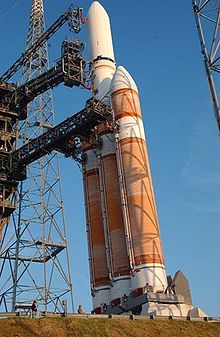- Delta IV Heavy
-
 The first Delta IV Heavy with three Common Booster Cores, prior to launch
The first Delta IV Heavy with three Common Booster Cores, prior to launch
The Delta IV Heavy (Delta 9250H) is expendable rocket, the largest type of the Delta IV family.
It is similar to the Medium+ (5,2), except that it uses two additional CBCs instead of using GEMs. These are strap-on boosters which are separated earlier in the flight than the center CBC. The Delta IV Heavy also features a stretched 5-meter composite payload fairing.[1] An aluminum trisector (3 part) fairing derived from the Titan IV fairing is also available.[2] This was first used on the DSP-23 flight.
Capacity (separated spacecraft mass) of the Delta IV Heavy:
- Low Earth orbit (LEO) 22,950 kg [3]
- geosynchronous transfer orbit (GTO) 13,130 kg (28,950 lb), more than any other currently available launch vehicle.[3]
- geosynchronous orbit (GEO) 6,275 kg
- escape orbit 9,306 kg
- C3 performance of 30 km²s−2: 5,228 kg
- C3 performance of 60 km²s−2: 2,521 kg
The Heavy's total mass at launch is approximately 733,000 kg, much less than that of the Space Shuttle (2,040,000 kg), but is not reused.
The Orion Multi-Purpose Crew Vehicle is planned for an unmanned test flight launch, known as OFT-1, aboard a Delta IV Heavy rocket in July 2013.[4] If launched, it would be its first launch into orbit.
References
- ^ "Delta Launch 310 – Delta IV Heavy Demo Media Kit - Delta Growth Options". Boeing. http://www.boeing.com/defense-space/space/delta/kits/d310_d4heavy_demo.pdf.
- ^ US Air Force - EELV Fact Sheets
- ^ a b "Delta IV Payload Planners Guide". United Launch Alliance. September 2007. pp. 2–5. http://www.ulalaunch.com/site/docs/product_cards/guides/DeltaIVPayloadPlannersGuide2007.pdf.
- ^ http://www.nasaspaceflight.com/2011/08/oft-1-nasa-orions-2013-debut-via-delta-iv-heavy/
Categories:- Delta rockets
Wikimedia Foundation. 2010.
